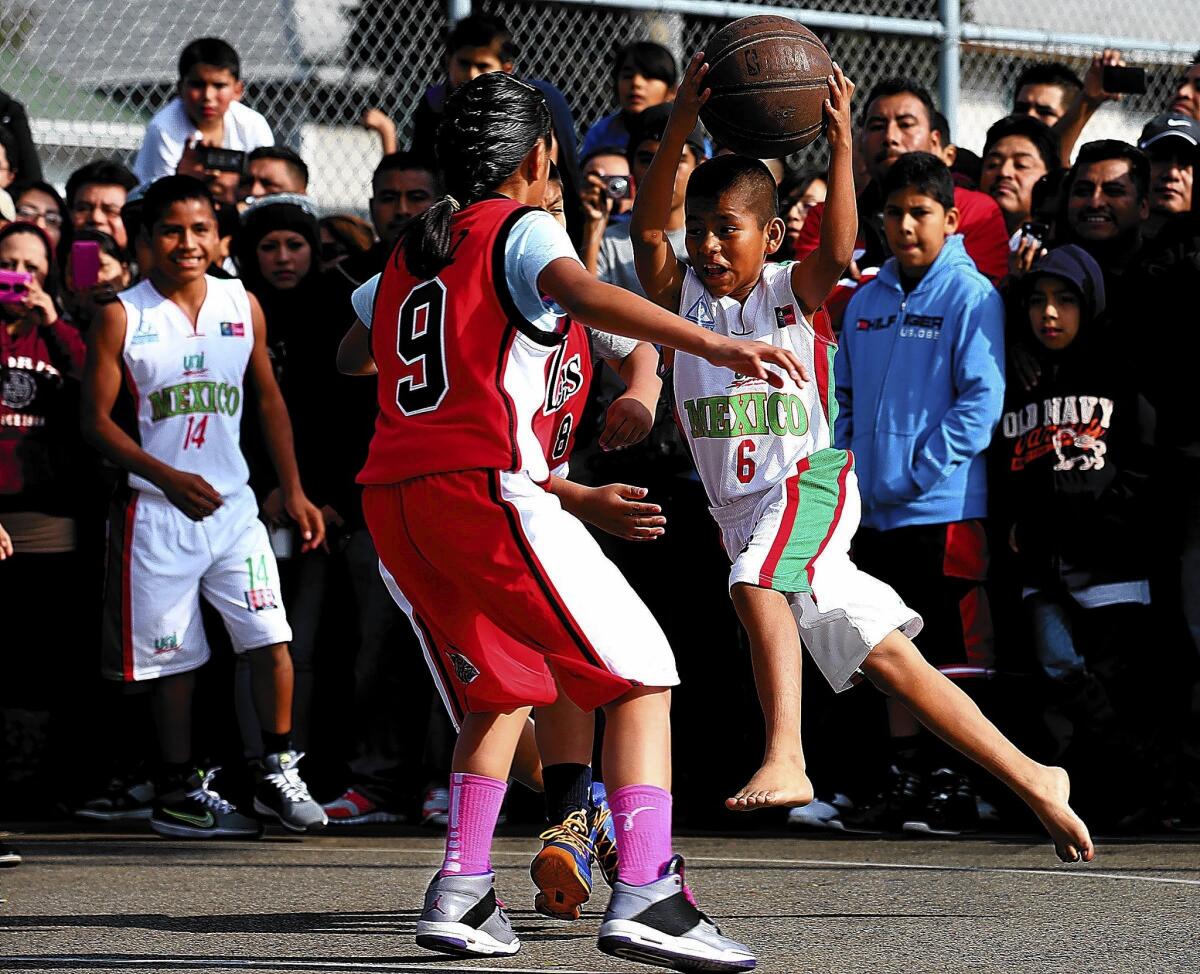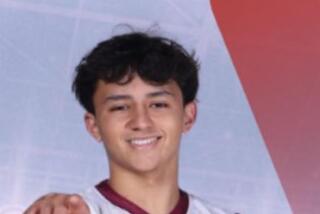Oaxacan youth basketball team competes on a global level

- Share via
The one they call Coco, because his head’s a perfect sphere, is barely 4 feet tall. Still, he’d be willing, he said, to take on Kobe Bryant.
And who would the winner be?
“Probably me,” said Haritskevin Merino Hernandez. “I’m little. I run faster.”
The 7-year-old basketball player recently arrived in Los Angeles with a team of 16 other children to compete in a Christmas Cup Tournament against L.A.-based teams. The Niños Triquis, as they are known because most are descendants of Triqui Indians, came from the Southern Mexican state of Oaxaca — from remote mountainous regions where basketball has been played religiously for generations.
Their parents live poor and marginalized, often packed into huts with up to 30 relatives. But the children have become famous across Latin America for their court skills. They have won championships throughout Mexico and in Argentina and the Dominican Republic. Next year, they will compete in Spain, then Africa.
The boys are tiny, ages 6 to 12, but on the court they are fierce. Wherever they go, they draw attention because they prefer to play barefoot. Tennis shoes were never something they could afford.
On Saturday, the Oaxacan community gathered at the Toberman Recreation Center in Pico-Union to welcome the players to a daylong tournament against local Oaxacan teams. They honored them with a 14-piece brass band, a traditional Mixteco dance and a parade.
Crowds circled the boys, shouting praise and snapping photos.
“I’m so proud,” said Leticia Diaz, 33, stretching her neck to get a peek. “They represent Oaxaca and my people. I want my children to see them and feel inspired.”
The Central Los Angeles resident had a 9-year-old nephew playing on an opposing team, the Wildcats.
“But I’m rooting for the Triquis,” she said. “I’m sure he’ll understand.”
The Niños Triquis have become a darling of Mexican television, their faces broadcast to the nation each time they return home from foreign games.
Three years ago, their coach, Sergio Zuñiga, launched the team with little fanfare. The native of Mexico City wanted to inspire indigenous kids from isolated villages to stay in school. Too many dropped out at as young as six or seven to work in the fields. Then they came north with relatives to find work in the United States.
“When you hardly have food and all you know is hard labor,” Zuñiga said, “it’s hard to stay motivated.”
The children loved shooting hoops, so the former sports trainer began a basketball academy using loans and donations from friends.
At the Academy of Indigenous Basketball, located in five regions across the state of Oaxaca, about 2,000 children now have the chance to study and play ball.
The top 150 kids — those who keep a B+ grade point average, practice their native indigenous language and help with chores around the house — are sent to study in Oaxaca’s capital.
Their lodging and meals are paid for with funds raised by the wife of Oaxaca’s governor. And with help from Mexican corporations, the students get to compete abroad as part of the official Niños Triquis team.
“They are stars,” Zuñiga said. “But most importantly, they are grounded. They know after every trip they will have to return to their families, to the same poverty they’ve always known. That’s why they play with so much intensity.”
Every trip abroad is a mix of luxury and making ends meet.
In Southern California, with help from local businesses, they will visit Disneyland and several universities. They also met the Lakers and attended one of their games. Kobe, unfortunately, was out injured.
Since the group cannot afford a hotel, the players and coaches — 26 people total — are sharing a four-bedroom house, courtesy of a local Oaxacan federation.
“It’s a lot of fun,” said Silvino Martinez de Jesus, 7. “And very loud.”
Before the tournament games began Saturday, the players were kept secluded inside the recreation center’s gymnasium. They needed to concentrate. They ate chips and drank sugary juice. They played with their coaches’ cellphones and chatted among themselves in Triqui.
Their competition gathered outside, discussing in English a strategy to beat them. The Eagles, a team from Culver City, was well aware of the Triqui team’s moves. They’d studied them on YouTube and had mixed feelings about their chances.
“I know they’re super fast,” said Vanessa Cruz, 11.
“And strong,” said her teammate, Valentino Carrasco, 10.
“But I think we can beat them,” Vanessa said.
“No way,” Valentino countered.
Moments later, the two watched the star team take its place on the court for their first game. They played against the Wildcats. The crowd gathered around hollering and clapping, eight to 10 people deep.
The whistle blew, and they were off.
The Wildcats were immediately overwhelmed. Within the first five minutes, the tiniest player on the Triqui team, 10-year-old Melquiades Ramirez, dodged one player after another, his feet black with dirt from the asphalt, until he had sunk the ball into the net not once, but more than a dozen times.
“Muy bien! Muy bien,” Zuñiga shouted from the sidelines.
The Wildcats hardly had a chance at the ball. Each time they touched it, a Triqui swooped in to steal it.
The final score: 47-3.
Vanessa and her teammates watched from the sidelines. They were next.
“OK,” she said. “Maybe we’re not going to win.”
esmeralda.bermudez@latimes.com
Twitter: @LATbermudez
More to Read
Sign up for Essential California
The most important California stories and recommendations in your inbox every morning.
You may occasionally receive promotional content from the Los Angeles Times.











